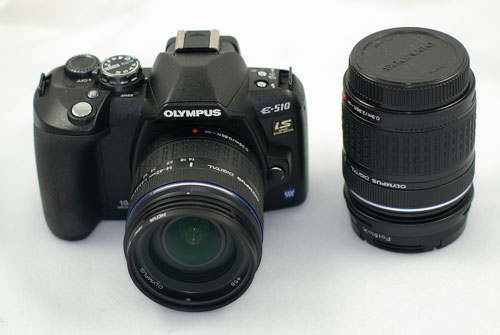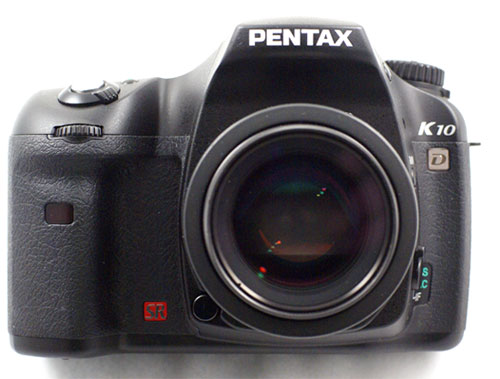Digital Camera Buyers' Guide - Year of the SLR
by Wesley Fink on November 23, 2007 6:00 AM EST- Posted in
- Digital Camera
Entry-Level Recommendations
Entry-level buyers don't normally have a collection of lenses for their new camera, so they are usually shopping for kits. Kit lenses are notorious for being mediocre, but that is improving in some of the kits we have recently seen. Our recommendations considered the quality and value of the kit itself, as well as the lens system for the entry DSLR buyers who end up enjoying digital photography and want to grow.

We are getting ready to be stoned, as our recommendation for best value in a kit is the 2-lens Olympus E-510 kit. The picture above is the complete kit, with both the 14-45mm f3.5-5.6 and tiny 40-150mm f4.0-5.6. These two small and light lenses cover the 35mm equivalent of 28mm to 300mm - a range from true wide angle to moderate telephoto. The 510 system finally realizes the promise of 4/3 with a small light body and small light lenses, but these two lenses are also two of the finest quality kit lenses available anywhere. This two-lens kit is available for as little as $675 at Amazon.com with free shipping, and you will find the E-510 two-lens kit at many web and brick-and-mortar stores for less than $800.
You get all the checklist features in this 10MP DSLR kit. This includes auto sensor cleaning and Live View as well as body integral image stabilization that works with all 4/3 lenses. This image stabilization - a first for Olympus - is selectable for either horizontal motion, which is generally best for panning and action, or both horizontal and vertical for general use, or off.
Olympus has improved their autofocus modules with each new generation, and the E-510 is the best one yet (outside of the E-3). However, the autofocus is still a weakness in an otherwise very capable system. It uses the somewhat dated 3-point autofocus, with a center cross sensor for greater sensitivity. In normal light, the E-510 is just as accurate and fast as other cameras, but it tends to search too much in low light conditions. Olympus introduced a fast and innovative 11 cross point 4-plane AF module in their new E-3. It needs to move down the line quickly to fix the last remaining issue with Olympus DSLR cameras. However, your reward with the E-510 is gorgeous, sharp, and evenly lighted lenses with the two kit lenses - and that is what photography is about.


Alternative: If low-light performance is a major concern, then you would do well to choose the Sony A100 kit with the 18-70mm kit lens. For a bit more money, the Pentax K10D gives you a great 11-point auto focus module, the truly useful hyperprogram feature that allows front and back dials to shift aperture and shutter speed in equivalent program steps, 3-plane image stabilization, all the other features, PLUS pro-type dust and moisture sealing.
The Safe Choice: The safe choice, and the one most buyers will make, is the Canon Rebel XTi or the Nikon D40x with the pedestrian 18-55mm kit lens. The problem with either choice is they don't include image stabilization, which is most useful with the slow kit lenses most camera makers sell with their entry cameras. In their favor, Canon includes auto sensor cleaning, but Nikon doesn't even bother with that. Nikon does provide a bit better image quality with their 18-55mm, so that makes it something of a toss-up.
It appears both Nikon and Canon are being hurt somewhat by their lack of mechanical image stabilization since they have both announced the availability of their basic kit lens with optical image stabilization. Yes, you will be seeing these IS and VR versions of the 18-55mm in future Canon and Nikon kits. There are arguments that can be made for optical IS instead of the mechanical body-integral IS that works with all lenses. However, the thought of spending more for the Canon 18-55mm with IS is difficult to stomach. What these announcements really say is Canon and Nikon are still resisting IS as a standard feature, though they are addressing this as a checklist item with IS/VR versions of their entry kit lens.










74 Comments
View All Comments
StephenP - Friday, November 23, 2007 - link
I forgot to say nice article :). Just a little too much focus on sensor mega pixels, anyone into photography knows that stuffing a camera with mega pixels isn't enough to make a good camera. The new 400D has "only" 10mp of resolution but, that provides for A3 or even A2 prints. Does one really need more? ok, you can crop more, sure but what is the real difference between 3000x4000 pixels (12mp) and 2800x3700 (10mp), 2-300 pixels isn't a very impressive extra crop. I'll take better high ISO performance to more MPs anyday.AsicsNow - Friday, November 23, 2007 - link
Yeah, the unless you are using a full frame camera, the lens itself is limiting the effective resolution to not much more than 1OMP anyways. If you want a higher resolution without just adding garbage pixels that will end up as adding more noise(look at so many point and shoots that have these issues these days) you have to goto a larger format sensor, aka. 4" x 5" which is WAY beyond the scope of any non-professional photographer unless if you're a rich prick yuppie :)The D40 is a steal though if you can live without manual focus, and I can't wait for the 18-55 VR to come out. (Though I wish I could afford a 12-24 instead hehe)
Lord 666 - Friday, November 23, 2007 - link
Wes, while it might be under NDA, what is the time frame for the Nikon 18-55 VR? Real soon, Q1, Q2 kind of thing? If they are coming out with it, very surprised they didn't launch for this holiday season.PS - You should do these updates more often. Way back a while ago you started writing the DSLR column, but didn't continue. Keep it up ;)
Wesley Fink - Saturday, November 24, 2007 - link
The Nikon Press announcement for the 18-55mm VR was 11/19/2007. The street price for the new lens is $199 and it is said to be available now.Camaban - Friday, November 23, 2007 - link
Hmm, so the Olympus E-510 is something like $570-$670, while on Amazon UK, it's £618.....Ya know, that's like the equivilent of $1250 or something.
Ridiculous.....
makulit - Friday, November 23, 2007 - link
Pentax? Ever heard of them???mcnabney - Friday, November 23, 2007 - link
No kidding!!!!!!11 months ago there was a review, RIGHT HERE, that identified the K10D as one of the best choices. It is barely mentioned here, even though it is being written elsewhere as a camera of the year due to the turnaround it has caused.
Why choose Pentax?
Built-in 3 axis image stabilization which works on ALL lenses.
Almost every Pentax and Pentax-compatible lens that has ever been made works just fine on this body
Dust and water sealed body - you have to spend double elsewhere to get this
Great prices and growing library of high quality and reasonably priced lenses
takumsawsherman - Friday, November 23, 2007 - link
This is an excellent point. Pentax has actually had great, low-priced cameras from the film days. The K1000 was an awesome camera on the cheap.Minolta Maxxum cameras (now Sony) was also a less expensive, but excellent camera. I have owned the Maxxum 7000, 600si and Minolta Maxxum Alpha 707 (my current camera). Although the 7000s were more durable, these cameras have excellent autofocus (they have almost always more fast and accurate than Canon/Nikon), great lenses, and are loaded with features. I am still looking for a cheap Maxxum 9 now that film is less popular.
If I were to get a new body, I would get a Sony A700, since my lenses will work, and be image stabilized (ever look at the cost of Canon's IS lenses? Ouch!). However, if I were buying a completely new system, I would be seriously tempted by Pentax, as I trust Sony less than I trusted Minolta :).
All of my pro photo customers are using Canon, even the Nikon fans. Anything big and they use a Hasselblad-Leaf system. I've heard lots of complaints about the D40x shooting JPEG poorly. Apparently to get good results one must shoot in RAW. I doubt any will switch to Sony or Pentax. Not because they aren't as good (and I think that the Sony is as good). But Minolta and Pentax have always been considered "second tier" amongst that crowd, and I just don't see that changing, whatever the merits.
Regarding lack of Minolta lenses, I have not noticed any difficulty getting good, reasonably-priced lenses, and there is a large used market in the form of eBay and B&H if one prefers something not-new.
Frumious1 - Friday, November 23, 2007 - link
I'm not sure how they "missed" the Pentax K10D....Page 4: "One of the amazing price drops of this season is the Pentax K10D, which can be found with the kit lens for around $750, or as a body alone for as little as $650. The Pentax K10D is the only camera in this group that has full dust and moisture sealing. It also features body-integral image stabilization, auto sensor cleaning, and an 11-point focusing system."
Page 5: "Alternative: If low-light performance is a major concern, then you would do well to choose the Sony A100 kit with the 18-70mm kit lens. For a bit more money, the Pentax K10D gives you a great 11-point focus module, all the other features, and pro-type dust and moisture sealing."
takumsawsherman - Saturday, November 24, 2007 - link
Maybe you missed the word "barely". I read the review. I know what it said, and agreed with the OP that Pentax got "barely" a mention, where it really produces because it has to in order to compete against the name power of Nikon and Canon.